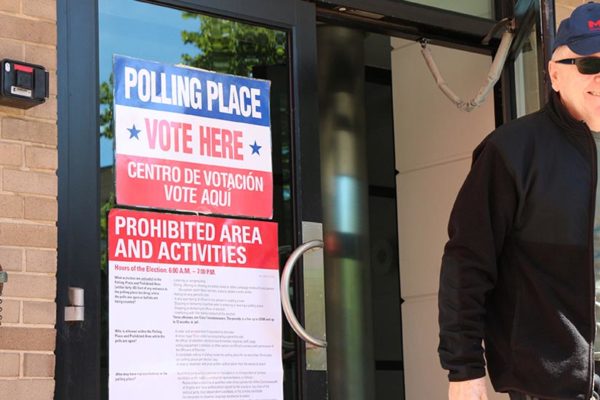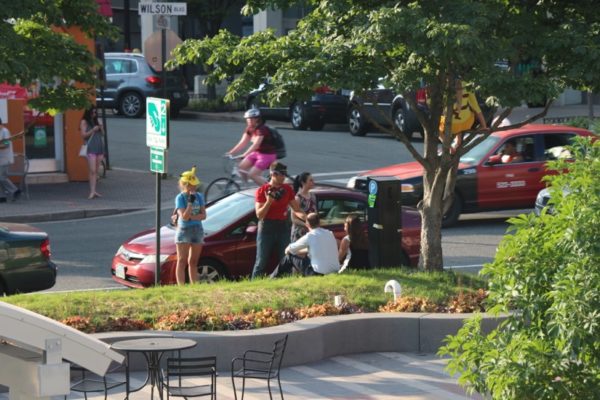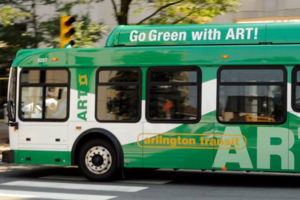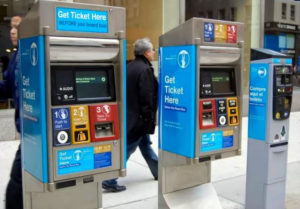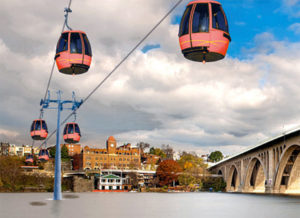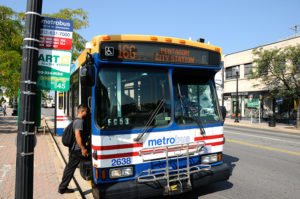 The Arlington County Board on Saturday approved a new 10-year transit plan that provides a vision for “more frequent bus service, more late night and weekend service, better north-south connections, and a new Premium Transit Network along Columbia Pike.”
The Arlington County Board on Saturday approved a new 10-year transit plan that provides a vision for “more frequent bus service, more late night and weekend service, better north-south connections, and a new Premium Transit Network along Columbia Pike.”
There’s an asterisk to the Transit Development Plan’s unanimous approval and the subsequent cheery press release, however. Responding to criticism from residents and the county’s own Transportation Commission, the Board directed County Manager Mark Schwartz to report back next year on possible improvements to the post-streetcar transit plan for Columbia Pike.
The Board’s guidance to Schwartz and county staff:
This generally ambitious and robust Transit Development Plan nevertheless falls short of the urgency and innovation needed to create a transformative transit network serving Columbia Pike and to realize its potential as a thriving and dynamic residential and commercial corridor.
Therefore, in adopting the FY 2017 -FY 2026 Transit Development Plan, the County Board also gives the following guidance to the County Manager and staff:
Look and Customization of Vehicles. The current TDP phases in the most modern version of current vehicles, WMATA buses and ART buses, with no unique features beyond re-skinning the buses on WMATA routes. Recognizing the significant logistical, cost and inter-jurisdictional challenges, please provide to the Board for consideration and analysis, during Q2 2017, the details of a possible path to customized and unique vehicles.
Articulated Buses. In consultation with WMATA, provide a plan by Q2 2017 to add articulated buses to the highest-demand routes on Columbia Pike (on either a pilot or permanent basis). Continue to assess effectiveness of articulated bus service and determine sustained levels of service for these routes through FY2026.
Headways. The current TDP identifies 6-minute peak headways and 12-15 minute off-peak headways for the Metrobus Connector “trunk line.” Please provide to the Board, by Q2 2017, a cost/benefit analysis (to consider efficiency, capacity, ridership impacts) of reducing the off-peak headways and ultimately achieving a 6-minute headway for 18 hours/day.
Coordination with Other Agencies. To effectuate this guidance, the County Manager and staff will coordinate as appropriate and necessary with WMATA and other federal, state, regional and local government agencies and transportation bodies.
Most of the public comments at Saturday’s Board meeting were complimentary of the overall plan, save the plan for the so-called Premium Transit Network. That plan seemed in many ways diminished from the “TSM-2” enhanced bus plan the county and supporters originally said was inferior to its since-cancelled streetcar plan for Columbia Pike.
Among the public speakers at the Board meeting was John Snyder, member of the Columbia Pike Revitalization Organization and a former streetcar booster. Snyder said the plan for Pike transit presented by county staff was inadequate to support growth along the corridor.
We had a debate for several years [about] TSM-2… and the streetcar. TSM-2 won the debate. Now, when I look at the plan, what is written in the plan has disappeared. The whole idea of premium new vehicles that have higher capacity: it’s gone. This wasn’t announced and it wasn’t part of a public process. We found out about it by looking at the Capital Improvement Plan. There’s no money to buy new buses. There’s still money in the plan for the transit stations if they’re maintained at the current level but the buses have disappeared. There’s great things in the Transit Development Plan, what’s in there is great and the consensus is that the county board supports all of it. But the concern is what’s not in there. We don’t see anything that’s going to help businesses with more frequent service on the off-hours. People go out to dinner not during the commuting hour, they go out to dinner after that time and they come back after that time. The idea of six-minute intervals all the time makes it reliable, frequent, easy and simple to use. We have the simplicity, the new 16M line is great in the way that it simplifies many of these different routes but it needs to have that frequency to help our businesses and connect our residents to that so we get out of the car mentality. Seventy percent of the people on the Pike do not use transit even to get to work. The percentage on other sorts of trips is even higher. We need to change that. That’s the whole idea behind the Pike plan and it has been supported by the Board for the last 15 years.
There is no plan to increase capacity. We understand that you’re going to be coordinating with WMATA on how we can get articulated buses. I heard the same thing in 2003 at the first meeting I attended regarding transit on the Pike. WMATA has a lot on its plate. What we need in that regard is a statement that says Arlington will. Arlington will go do this, we will go get the additional buses, we will get the additional facilities needed to maintain them and we’re going to do that by a particular date.
Some were more charitable about the plan as currently conceived.
“These critics failed to appreciate that no amount of service upgrades will defeat car culture,” said perennial County Board candidate Audrey Clement, who’s running as an independent this year. “If state of the art transit technology were the solution, the Silver Line would not be running half-empty in the I-66 median with cars parked on the interstate on either side every day.”
Dennis Leach, Arlington’s Deputy Director of Transportation, said the enhanced transit stations and other amenities included in the Premium Transit Network plan will, in fact, move the needle in terms of making transit a more attractive option along the Pike.
“The premium amenities are proving those high-quality stations with near-level boarding, longer platforms and real-time information,” he said. “These stations are the front door of transit in the corridor. It is shifting this entire corridor to off-vehicle fare collection. We’ve already started work on transit signal priority and we are committed to actually implementing it in the full corridor.”
“We are actively coordinating with Metro to replace the current buses with modern low floor vehicles,” Leach added. “The intent is to implement a unified brand for this premium transit network.”
“I would say this was the most intensive and comprehensive transit update that the county has ever done,” Leach said of the overall transit plan. “I was here for 2011, this effort well exceeded that. We looked at every route and every part of this community to bring these recommendations before you.”
The full press release from Arlington County, after the jump.
(more…)



